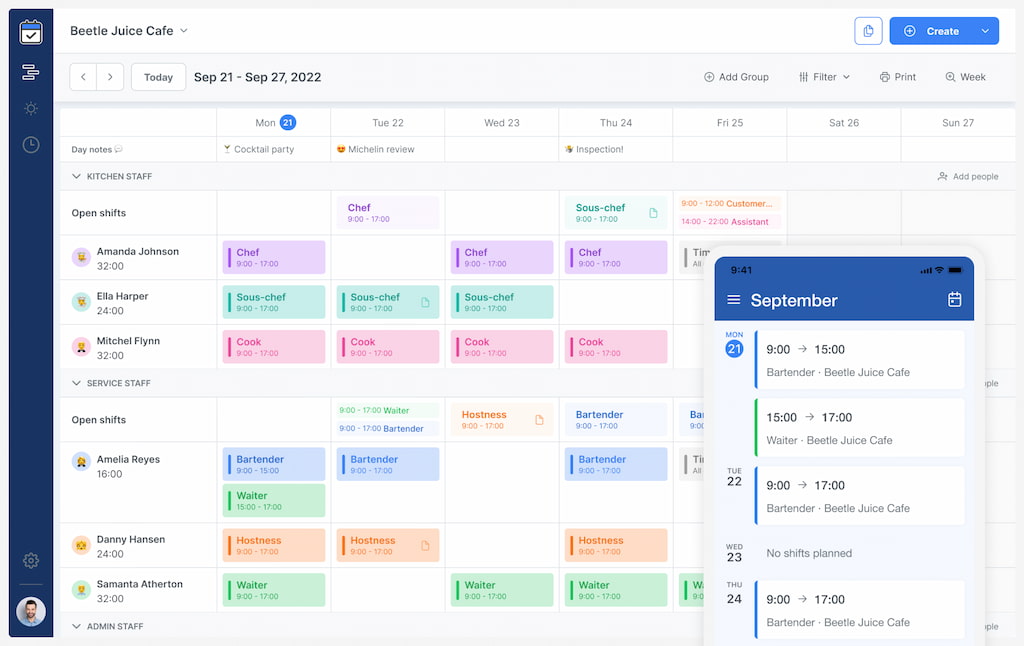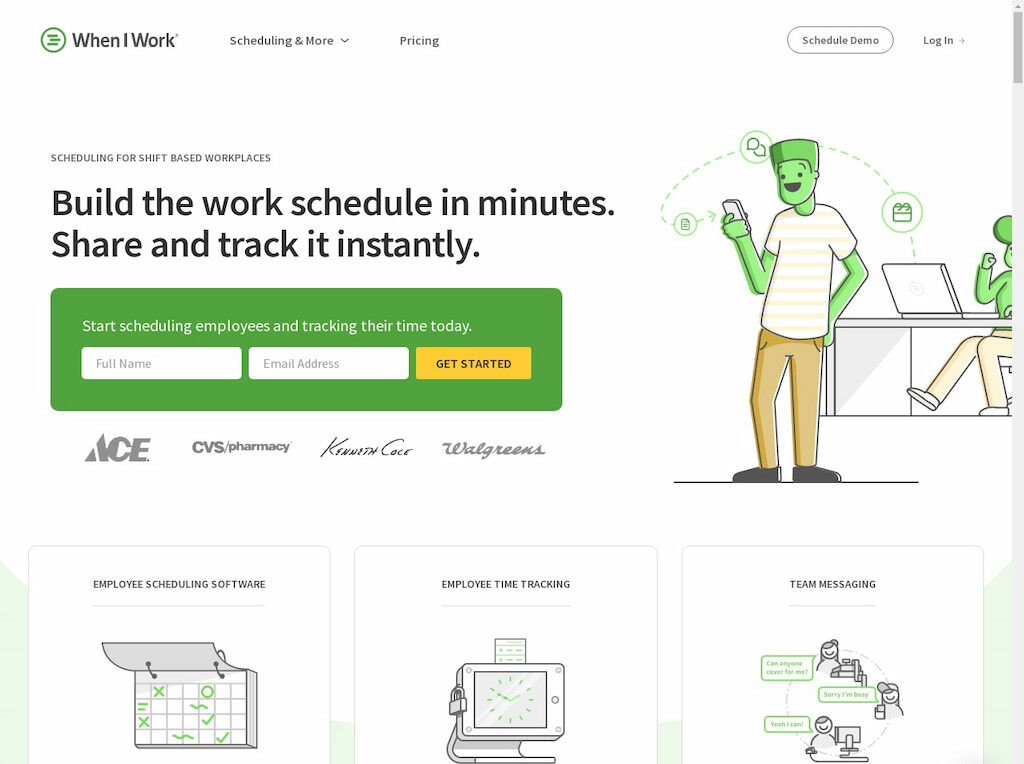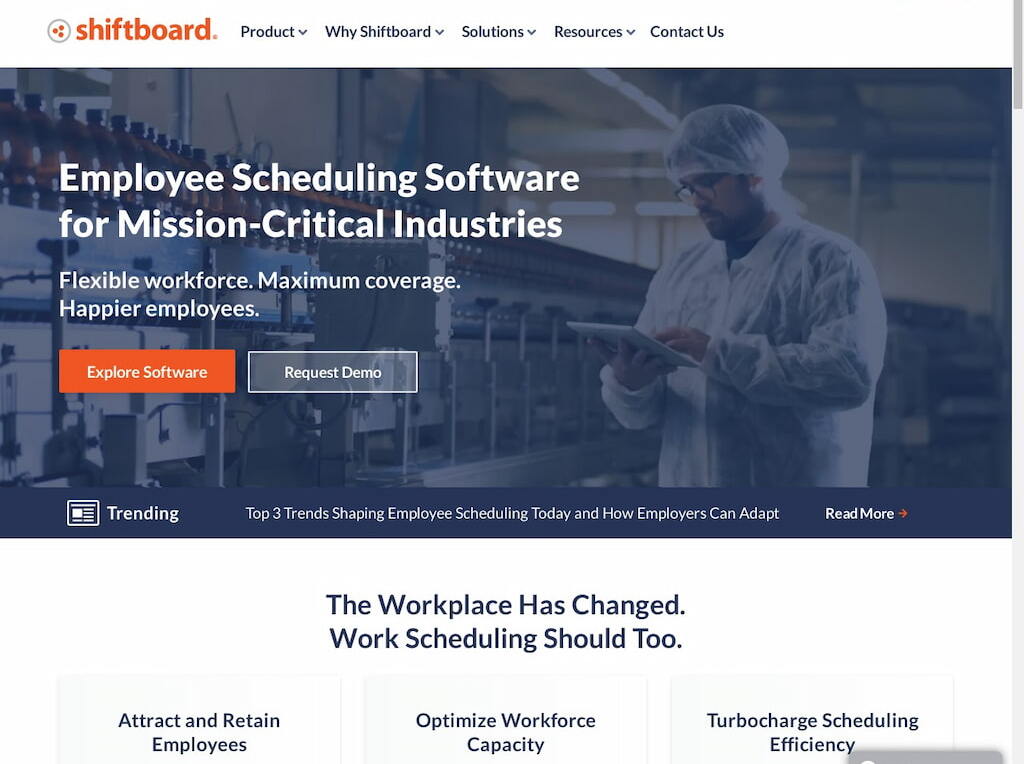Shift employment can be a game-changer for both businesses and employees. It makes the most of every hour in the day, increasing production and overall efficiency. Shift work schedules are common in industries that need round-the-clock coverage or face spikes in demand.
Despite its benefits, shift work still isn’t as widespread as the standard 9-to-5 model, often because many employers don’t know how to set up a proper shift work schedule.
In this article, we’ll answer the question “what is shift work”, explore the different types of shift work and shift workers, and highlight some useful free employee shift scheduling apps. You’ll also learn how to choose the right shift work schedule to keep your business running smoothly.
🔍 What Is Shift Work?
Shift work refers to any employment schedule where staff work in rotations, often covering non-standard hours outside of the typical 9–5. This model is common in industries that require 24/7 coverage, such as healthcare, manufacturing, hospitality, logistics, and security.
Shift work schedules are designed to:
- Optimize labor availability
- Match high-demand periods
- Maximize productivity across all hours
![what is shift work: definition, types, jobs+best tools [2023]](https://blog-cdn.everhour.com/blog/wp-content/uploads/2022/11/rotation.gif)
How does the shift work operate?
Employees are grouped into shifts that cover different blocks of time throughout the day. Depending on the structure, this could mean morning, afternoon, night (including an NOC shift), or rotating shifts.
💡 Example:
A hospital might operate three 8-hour shifts:
1️⃣ Morning: 7am–3pm
2️⃣ Evening: 3pm–11pm
3️⃣ Night: 11pm–7am
Each team hands over responsibilities to the next, maintaining 24-hour coverage with minimal disruption.
👥 Types of Shift Workers
The kind of shift schedule you implement depends on your workforce type. Here are the most common categories:
🕘 Full-time workers
- Typically 40+ hours/week
- May qualify for health insurance, PTO, and benefits
- Often fixed shifts
![what is shift work: definition, types, jobs+best tools [2023]](https://blog-cdn.everhour.com/blog/wp-content/uploads/2022/11/pexels-fauxels-3184357.jpg)
🕓 Part-time workers
- Usually less than 40 hours/week
- Hourly wage
- Ideal for retail, food service, and flexible roles
![what is shift work: definition, types, jobs+best tools [2023]](https://blog-cdn.everhour.com/blog/wp-content/uploads/2022/11/pexels-mizuno-k-13456097.jpg)
❄️ Seasonal workers
- Hired for peak seasons (e.g., holidays, summer)
- Temporary but crucial during surges in demand
![what is shift work: definition, types, jobs+best tools [2023]](https://blog-cdn.everhour.com/blog/wp-content/uploads/2022/11/pexels-gary-barnes-6231881.jpg)
⏳ Temporary workers
- Fill short-term gaps due to medical leave, special projects, or parental leave
- Contract-based or through agencies
☎️ On-call workers
- Only activated when needed
- Common in healthcare, emergency services, or IT support
⏰ Common Work Shift Patterns
🔹 First shift (Day shift)
- Hours: 9am–5pm
- Standard work hours for most industries
- Peak customer service, production, and administration
🔸 Second shift (Afternoon/Swing shift)
- Hours: 1pm–9pm (varies)
- Popular in manufacturing and service-based industries
- Requires overlap with day and night teams
🌙 Third shift (Graveyard/Night shift)
- Hours: 11pm–7am
- High compensation due to unsociable hours
- Essential in hospitals, transport, law enforcement
🔁 Rotating shifts
- Employees alternate between morning, afternoon, and night shifts
- Used in 24/7 industries to distribute workload fairly
📅 Split shifts
- An employee works two segments in a day (e.g., 7am–11am & 4pm–8pm)
- Common in hospitality and transportation
🧊 Fixed shifts
- Same shift every day (e.g., always evenings)
- Predictable, good for routine-dependent teams
✅ Why Use a Work Shift Schedule?
Using structured shift schedules brings value to both business owners and employees.
For employers
- 📈 Boosts productivity during peak hours
- 🧮 Controls labor costs and limits overtime
- 🎯 Improves scheduling efficiency and employee coverage
- 🛠 Reduces absenteeism with clear communication
- ⚖️ Ensures compliance with labor laws and rest requirements
For employees
- 📅 Increased flexibility to balance personal life
- 💸 Access to shift premiums (e.g., night differentials)
- 🧘 Work-life balance for students, parents, or caregivers
![what is shift work: definition, types, jobs+best tools [2023]](https://blog-cdn.everhour.com/blog/wp-content/uploads/2022/11/office-good-1.gif)
❓ What Scheduling Work Shifts Are the Best?
There isn’t a single “best” shift to work, which is not surprising because every business has its own unique needs. The benefits and downsides of each work shift vary by industry, but they are most noticeable to the individual worker.
The ideal shift work schedule is contingent on a variety of variables, including your business, the required staff size, legal requirements, and more.
It is your duty as an employer to evaluate each employee’s capabilities and mental and physical demands to assign them to the best work shift possible. It’s best practice for workers to learn about their upcoming shifts well in advance so they have time to change their sleep schedules.
To do that, you need to schedule shifts in advance using proper shift management and a time clock app like Everhour–not just Excel.
🔧 5 Best Employee Scheduling Software 2024
Making work schedules for employees is a two-way process. Therefore, businesses must have a platform that enables two-way communication between management and employees. Here are 5 employee scheduling apps that can help you do just that:
| App Name | Best For | Key Features |
|---|---|---|
| Shifts by Everhour | Real-time availability tracking | Open shift visibility, task assignments, auto-updating schedule |
| Zelos | Manager-controlled shift assignments | Fair shift distribution, employee applications, low-shift free plan |
| Shiftbase | Self-scheduling with auto-updates | Open shift lists, auto-refreshing schedules, flexible team access |
| Sling | Team-driven scheduling | Open shifts, shift swapping, internal chat, news feed |
| Connecteam | Custom shift approval settings | Open shifts, admin approval options, complex plan structure |
Shifts by Everhour

Everhour is a highly customizable time tracker and project management tool for managing collaborative staff scheduling for any type of business activity. It enables management to set up multiple workplaces if the company operates out of many physical locations, or wishes to create unique timetables for certain teams or departments.
Shifts by Everhour is unquestionably one of the best employee scheduling tools available due to how simple it is to create, update, and manage shifts on the app. You can create schedules from scratch or by just copying an existing one or see who’s absent or present. Mobile tracking and clock-in/clock-out is also available.
It also helps avoid scheduling problems, such as alerting you to any shifts that overlap as well as providing current time off requests and availability.
HomeBase
![what is shift work: definition, types, jobs+best tools [2023]](https://blog-cdn.everhour.com/blog/wp-content/uploads/2022/11/All-in-one-Employee-Scheduling-Time-Clocks-Payroll-More-Homebase.jpg)
Homebase lets small business owners schedule shifts in detail. Everything you need is included in its free plan, including time clocks, employee mobile apps, time and attendance tracking, and the ability to schedule more than 10 days in advance.
Additionally, you can obtain daily labor reports and track overtime and breaks for compliance, which makes employee time tracking a breeze. Its paid plans have reasonable prices and loads of extra features. The user-friendly interface enables you to operate on Windows or Mac PCs, and its apps are compatible with Apple and Android mobile devices.
Connecteam
![what is shift work: definition, types, jobs+best tools [2023]](https://blog-cdn.everhour.com/blog/wp-content/uploads/2022/11/Connecteam-.jpg)
With Connecteam, you can assign shifts with a single click, duplicate them, drag them into place, use templates, and perform bulk activities, simplifying the entire process from planning to distribution. Additionally, it allows employees to receive push notifications and all the details they require instantly.
When I Work

WhenIWork is an employee timesheet app that includes a time-tracking feature for tracking shifts and tasks. This enables you to manage your staff and keep tabs on their hours all without leaving the app. It also enables your staff members to coordinate shift swaps, manage their availability, and submit time-off requests.
ShiftBoard

Shiftboard is another impressive staff scheduling software that lets you overcome business obstacles such as increasing employee retention, cutting labor costs, and guaranteeing compliance. It is targeted at industries with critical functions, like manufacturing, oil & gas, and healthcare.
🤔 How to Choose a Shift Work Schedule?
Setting up a shift schedule isn’t one-size-fits-all. The best setup depends on your business needs and team preferences. Here are key factors to consider:
📏 Shift length
Longer shifts, like 12-hour ones, can offer better work-life balance and fewer workdays—ideal for many 24/7 operations.
🕐 On-off cycles
Decide how many days employees work before time off. Common patterns include:
- Weekends off (Saturday–Sunday)
- Weekdays off (non-consecutive)
- Set days on/off (e.g., 4 on, 2 off)
📅 Schedule format
Choose between fixed shifts and rotating shifts. Rotating shifts alternate between different shift patterns like the Panama schedule, while fixed shifts stay the same each day.
➕ Overtime planning
Overtime—whether optional or required—can help manage peak demand without hiring more staff. It also increases earnings when managed well.
🏁 Final Thoughts: Shift Work in 2025
In 2025, shift work remains a strategic advantage—not just a necessity. When managed well, it supports employee wellness, maximizes operational hours, and boosts profitability.
➡️ Whether you run a retail shop, a clinic, or a call center, embracing small biz management software like Shifts by Everhour can future-proof your operations with smart planning, clear communication, and flexible workforce management. It is a free work scheduler maker that simplifies the scheduling process.

